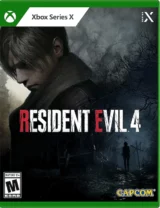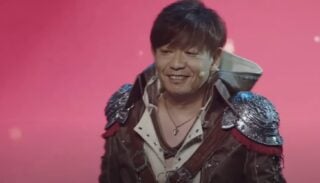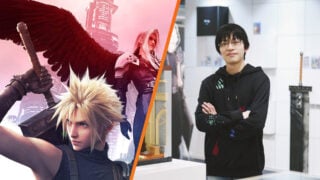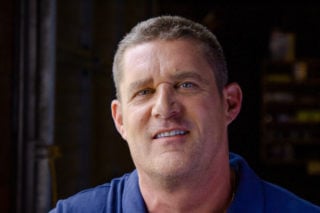Devil May Cry, Dragon’s Dogma director Hideaki Itsuno explains why he left Capcom, and what’s next
Itsuno-san discusses Lightspeed Studios and its plans for a AAA action game
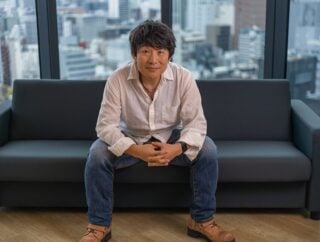
When it comes to blockbuster video games, Capcom is the modern gold standard. Over the past seven years, the Resident Evil and Monster Hunter firm has produced hit after hit at a seemingly impossible pace, regularly appearing in Game of the Year lists and with annual profits to match.
There are a multitude of reasons for the company’s ongoing purple patch, not least that it boasts one of the most enviable war chests of franchises of any game company. But it’s that last bit that indirectly persuaded one of its most experienced directors to quit last year.
Because when you’re on such a strong roll revitalizing classic IPs like Street Fighter, Onimusha, and Devil May Cry, there’s understandably little incentive to assign your most experienced creators to original IP built from scratch.
With 2012’s Dragon’s Dogma, Hideaki Itsuno created one of Capcom’s last wholly original AAA single-player franchises (arguably the next didn’t arrive until last year’s Kunitsu-Gami: Path of the Goddess). A 30-year company veteran, Itsuno is best known as the director behind the last three Devil May Cry games, both Dragon’s Dogma titles, and classic fighting games such as Power Stone, Rival Schools, and Capcom vs. SNK.

It came as a surprise then that the celebrated designer opted to end his time at the company last year, following the release of another title from the Capcom hit conveyor belt, the RPG sequel Dragon’s Dogma 2. However, approaching his mid-50s, Itsuno contemplated his future, and decided he wanted to spend the remaining years of his career creating something new, rather than more sequels to franchises he felt he’d perfected.
“For me, based on my age, this is my last chance,” Itsuno told VGC during a recent visit to his new studio, Lightspeed Japan, where he was given the opportunity to build an entirely new team and project by owner Tencent. “The gaming industry has decreased the number of AAA releases, and I was asked to create a new AAA. I’m not young anymore, so more than ‘now it’s the right moment’ it’s more like, ‘this is my last chance’ to challenge myself.”
He continued: “For Capcom, creating Devil May Cry and Dragon’s Dogma sequels is the top priority, and keeping in mind that making a game takes four or five years, this might be my last big opportunity.
“I’m not young anymore so more than ‘now it’s the right moment’ it’s more like, ‘this is my last chance’ to challenge myself.”
“Before you realized you are working on making Devil May Cry 6 or 7. It’s not like I don’t want to make them, I do, but it’s hard to balance the time it takes with the personal satisfaction of making them and with Devil May Cry 5 and Dragon’s Dogma 2 I already did what I wanted to make.”
Itsuno is now leading the Japanese arm of Tencent’s Lightspeed Studios, where his new team is building a ‘triple-A action game’. On Tuesday, Lightspeed announced the opening of a second Japanese studio in Osaka – the hometown of Capcom – and the hiring of several other Devil May Cry and Street Fighter veterans.
Speaking to VGC at Lightspeed Osaka ahead of the news, Itsuno said that around a third of the studio’s some 40 employees had come from Capcom, and that he believed his first title at the new company would benefit from their shared experience.
“Very few studios in Japan are taking on the challenge of building original AAA IP from scratch. That’s exactly what we’re doing,” he said.
Read on for our full interview with Hideaki Itsuno, covering Lightspeed Studios’ progress, his reasons for leaving Capcom, thoughts on Dragon’s Dogma 2, and more.

Most companies seem to be avoiding the AAA space right now due to market volatility. So what makes you confident that you can build a successful original IP in that space?
The goal of this studio is to create a game, an IP, for consoles. I believe that unless you make a game at a AAA quality level, it doesn’t become even an option for the users. After gathering a lot of information, I thought about creating a game with a AAA quality that becomes the first choice for players. Even within the AAA games, there are several budget sizes, though, so I’m taking the challenge of creating one that doesn’t need a huge budget to develop.
So even though you refer to the project as AAA, it sounds like you’ve been sensible in terms of budget and the scale of the team?
My style of making games is, first of all, to release the game. We have a plan, and we try not to go over the budget. Normally, if you have a huge budget, the release gets delayed. It’s better to work with just the right amount of budget, in my experience.
Is making games more efficiently a key differentiator in what we’re seeing currently in terms of the struggles of triple-A western publishers, compared to Japanese companies like Capcom and Sega, which seem to get games out much faster and cheaper?
As a director, releasing the game is the most important thing. In order to do that, you need to control the deadlines and budget for the company that is investing the money. If you don’t align properly, you get delays, an increase in budget, lower quality than expected, and then you have to increase the costs to reach the desirable quality. More than Capcom, it’s the development team that balances and controls that.
“Very few studios in Japan are taking on the challenge of building original AAA IP from scratch. That’s exactly what we’re doing”
You’ve announced a new Osaka studio to complement your existing Tokyo branch. Osaka is also the home of your previous employer, Capcom. Why is Osaka a great place to make games?
That’s a hard question. In my opinion, Tokyo, Osaka, or even San Francisco… the place isn’t important. In my case, I have many connections in Tokyo and Osaka to create the core team with experience in AAA games. Also, I can go to the office from home!
At GDC, you said you’re making a “Japanese-style” action game. What defines a Japanese-style action game?
This is not a game with samurai and so forth. When I talk about “Japanese style,” I mean like the type of action games I made at Capcom. Strong animation, character design, creativity, a high skill ceiling, and a variety of action are the focus of the game. So I hope that players who love action games love this game too.
You mentioned three key hires in your announcement today: Devil May Cry writer Toshihiro Nakagawa (aka Bingo Morihashi), DMC and Street Fighter character designer Daigo Ikeno, and veteran Capcom illustrator Bengus. What can you tell me about why you approached them?
Although we’re a new studio working on a new game, it’s good to be able to work with people whom I trust, like Mr. Nakagawa. I have been working with him for decades, since Devil May Cry 2, and he’s one of those core members who understands me very well. He worked as a freelance scenario writer, and he came when I called him. If we mix my taste and his taste, I believe we can make a great game together.
Ikeno-san is also participating as an art director this time, and Bengus-san has a very high level of understanding and is a very unique man – he was a legendary designer at Capcom.

It’s all about a sense of trust… we know exactly what each of us wants. And it’s not just these three people: I also hired some other people I worked with from before at Capcom, so even though this is a new studio, I’ve gathered those people who I trust to make sure that this is going to be a successful game.
One third of the team is made up of people I previously worked with. The new team members are also great, as well as the members who aready were at Lightspeed Studio. They are all great. I’ve gathered a team where everybody is great.
It’s been six years since you released your last character action game, Devil May Cry 5. Now that you’re returning to the genre, have you taken any learnings from action games released since then?
After Devil May Cry 5, many single-player games were released… Leaving aside whether they were a hit or not, I don’t have any particular thoughts about the games of that same style. There were many games with a style between Dark Souls and Devil May Cry, but there was nothing too surprising. I got more impacted by games outside of that range, like the recent Indiana Jones game.
It seems like, increasingly, every action game is a Soulslike. Are you aware of any oversaturation in the genre, and is that something that puts you off entering it?
I didn’t create a company to make a high-end version of existing games with a similar gameplay, story and character design. I came to Lightspeed Studio to create an action game with a different value, gameplay than the existing ones. I appreciate their contribution but I’m not going to create the same thing.
“There were many games with a style between Dark Souls and Devil May Cry, but there was nothing too surprising. I got more impacted by games outside of that range, like the recent Indiana Jones game.”
This is the first time you’ve held an interview since leaving Capcom. So, why did you decide it was the right time to leave, after 30 years?
For me, based on my age, this is my last chance. The gaming industry has decreased the number of AAA releases, and I was asked to create a new AAA [by Lightspeed]. I’m not young anymore, so more than “now it’s the right moment,” it’s more like, “this is my last chance” to challenge myself.
For Capcom, creating Devil May Cry and Dragon’s Dogma sequels is always going to be the top priority, and keeping in mind that making a game takes 4 to 5 years, this might be my last big opportunity.
So basically, you didn’t want to spend your remaining years making Devil May Cry and Dragon’s Dogma?
Yes, that’s it. Before you realized you are working on making the Devil May Cry 6 or 7. It’s not like I don’t want to make them, I do, but it’s hard to balance the time it takes with the personal satisfaction of making them, and with Devil May Cry 5 and Dragon’s Dogma 2, I already did what I wanted to make.
At which point exactly did you decide you wanted to leave Capcom?
I held several talks while I was working on Dragon Dogma 2, but at that time, I didn’t even think of leaving while making the game. I wanted to finish it and after release, there still was some work to do, so I decided to go to the new studio once I was done with all of that.

How do you reflect on Dragon’s Dogma 2? Critically, it was very well received, but there were divisive reactions from some fans.
“If it sells at this level, all good”. Meaning that if the game was loved by so many, it’s all good. I made the game not like a Nintendo one to be liked by all the people, but for a certain type of audience, so it’s normal if some people outside that target audience don’t like the game. However, people who enjoyed the game really loved it, appreciated the details and work. I’m very proud of it.
Sega president Shuji Utsumi recently credited the company’s modern success to taking a global-first approach to game creation. How are you approaching game creation at Lightspeed? Are you targeting a particular audience, like with Dragon’s Dogma, or aiming more broadly?
When I talk about the audience, I don’t talk about country, nationality, genre, or so forth, but people who enjoy that playstyle. Capcom is a company that has targeted worldwide since the beginning with Street Fighter and other games, it becomes natural to target worldwide. The thought of ‘let’s create a game that hits worldwide’ is already intrinsic. Well, with the exception of Rival School! (Laughs)
There are many ways a game can be fun to play but for action games is more universal. I keep in mind to create scenarios and characters not to be hated by a specific region – that’s what Sega is doing right, for example. But it’s also what Capcom and my team has been doing since the beginning.
Would you like to work on another fighting game or RPG in the future? For example, you have said in the past that you’d like to make another Capcom vs SNK.
I do want to make a fighting game like Capcom vs SNK, but now I’m neither Capcom nor SNK! If they license it to me, though, I want to make Capcom vs SNK 3. I want to make a fighting game, and it’s at the top of my list of games I want to make!
I do want to make an RPG too, but I just made one, so it’s not like I want to make one right now. Maybe after some time.
“For Capcom, creating Devil May Cry and Dragon’s Dogma sequels is always going to be the top priority, and keeping in mind that making a game takes 4 to 5 years, this might be my last big opportunity.”
Capcom is enjoying one of the most successful periods in its history, but do you think it could become a victim of its success if, like you, it doesn’t give its experienced creators more freedom to create wholly original games?
That’s a tough question. In my case, I’m 55 years old and I happened to get this opportunity. For young people, working on a sequel is a great experience. They can learn a lot and use in creating the next games. The people working on the sequels right now are extremely good, so the young people can learn from them.
You’re creating an original action game, and presumably, Capcom will continue the Devil May Cry series. Will it be strange competing with that?
I’m extremely proud of Devil May Cry 5, and I don’t think I can improve on it, so competing with a new IP is going to be hard. But at the same time, after making DMC4, I thought it was going to be impossible to create something better and I think I managed it. It was the same with Dragon Dogma 2, I thought it was going to be impossible to make something better than the first one, so who knows.
Did you leave any advice for the Devil May Cry team when you left?
Officially, I didn’t give any, but at a personal level, I wished good luck in person to the members I know. I still go drinking with some of them.
In a twist of fate, I’m interviewing the original Devil May Cry director, Hideki Kamiya, later today. He mentioned during a recent panel that you started socializing for the first time since leaving your respective companies. Do you think you could collaborate in the future?
Two directors working together are going to fight for sure. It sounds fun, but we would be getting into fights. We are of the same generation, and it sounds fun, but it wouldn’t work!
More than working together, maybe I could be in charge of a part and he could be in charge of another one but… it’d be complicated. We have different styles. I’m strict but he also he is, in a different way… It’d be tough.
Do you have a question for Kamiya-san?
Please, tell him not to release his game at the same time as ours. We started development at the same time, so I’d like him to have at least three months between the release time. I have no problem with the announcement date, but let’s avoid overlapping on the screening period for Game of the Year!




